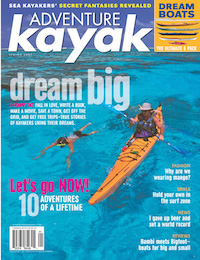There’s a picture of me eating lunch. In the photo, four of us are sitting on a beach log in the heart of the lower Columbia River’s winter duck-hunting territory. We’re all wearing identical drysuits—orange and black—and drinking out of Thermoses festooned with stickers from every outdoor company you could imagine. We all have fancy, black-like-my-soul carbon fibre paddles and top-of-the-line British-style kayaks. My buddy Steve is telling a joke, probably a kayaker joke no duck hunter would understand.
My friends and I could be a gang. All that’s missing are tattoos and a secret handshake.
When I started sea kayaking, I thought I’d escaped the world of uniform-wearing outdoor geeks who all drive Subaru Outbacks and wear duds from the North Face—a gang I’d joined gradually over years of backpacking, skiing and mountaineering with guys who must have been born in Gore-Tex.
I found myself venturing away from the mountains and down to the Columbia River, which has a couple of centuries of the blue collar life of commercial fishing, logging and bar-piloting under its belt. The folks who live along the lower Columbia had been out in the elements for generations in lowbrow gear. They loved being on the water as much as I did, and they still do.
Like a breath of fresh air wafting down my home river, the gang colours faded away when I left the mountains. Camo and rubber boots replaced miracle fabrics. Boats built in garages were as common as modern ones. Guys paddled in yellow rubber raingear, Xtratufs and even jeans. I met a guy who built his canoe out of canvas and wood and held it together with large binder clips from an office supply store—and it floated. Whatever our boats were made of, we were rubbing elbows comfortably, enjoying our favourite part of the planet.
Then something went amiss. The gangsters expanded their territory, and I’m one of them, again.
It was bound to happen.
I’ve evolved from a summer flatwater paddler to one who seeks out wind, rough water and surf year-round. Form follows function: we have high-end stuff because we are doing high-end paddling. The orange drysuit is a great piece of gear, and sure beats being wet and hypothermic. My pal Andrew has a new Subaru because it doesn’t break down on the way to the put-in like his old Volvo. We’re still nice folks, we just have better stuff.
I have no intention of giving up gear that works, but I‘ve also seen a divide form. To a guy in rubber overalls with a boat made of office supplies, we look like a bunch of super-intense kayaking snobs who will look down our noses at their kit.
Others may see us as urbanite tourists invading their back 40 in space-age suits—the advance guard of the Gore- Tex army that will turn their neighbourhood waters into the next recreational getaway with latte shops they don’t want and can’t afford.
YOU CAN LOOK LIKE A GANG, JUST DON’T ACT LIKE ONE
If we look like a gang, it’s our job to be sure we don’t act like one. If we let the fancy gear go to our heads, we’ll miss the key reasons we kayak: to experience new places, new people, and for the camaraderie of being on the water together.
I make it a point to chat with everyone I meet on the water. It drives my buddies nuts, because I’m the last to load my boat when they’re ready to go, but I remind them that’s how I ran into them too, way back. And I have a new appreciation for a place called the Sea Hag.
The Sea Hag is a watering hole in Ilwaco, Washington, a fishing and bar-pilot town at the mouth of the Columbia. One time after a hard day of paddling, we stumbled in and groped our way through clouds of second-hand smoke to a table in the back, while fishermen hovered at the bar with raised eyebrows. When I went to refill my beer, I decided enough was enough. We ended up chatting at the bar, swap- ping stories about our mighty river. I was amazed by the conditions they’d ventured out in that would have me snug in my bed in Portland. They were equally astounded at where we went in 21-inch-wide boats in December.
Ultimately, drysuits or camo, we’re all just aquaholics enjoying the watery part of the world. And in a society where style often trumps substance, it’s the people we meet on the water who often turn out to be the most genuine. Let’s keep it that way.
See you at the Sea Hag, whatever you’re wearing.
Neil Schulman is an Oregon-based paddler and part-time fashion consultant specializing in waterproof–breathable fabrics. For dining at the Sea Hag, he recommends a yellow rain slicker.




